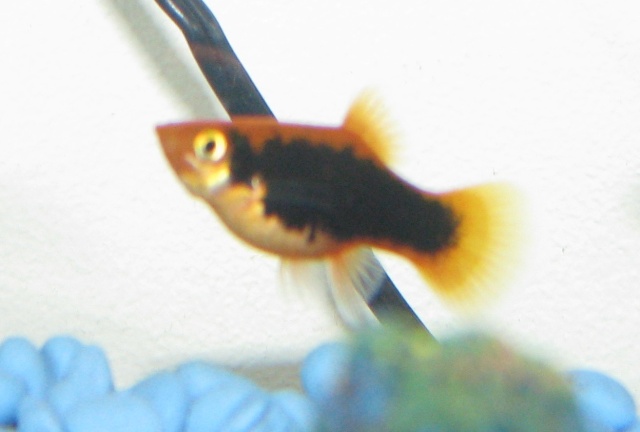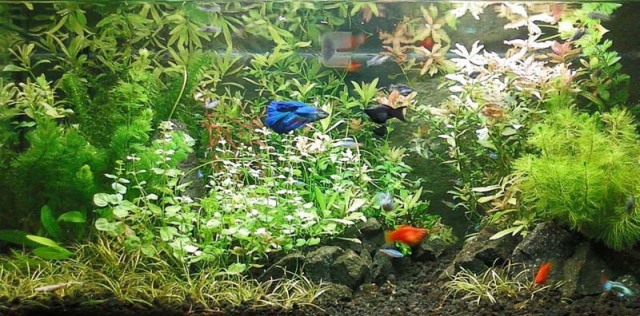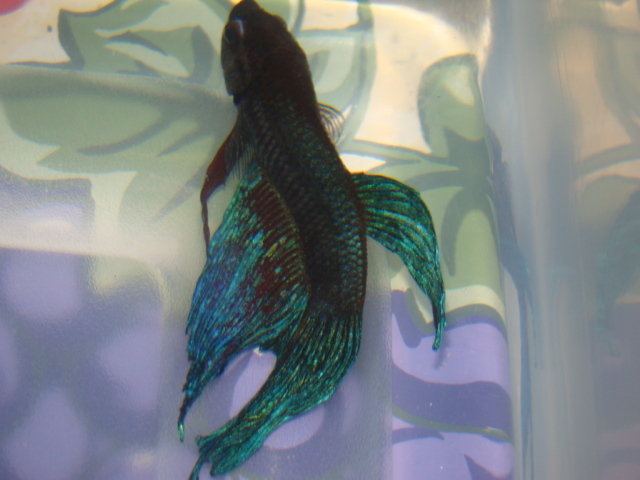QuestionQUESTION: Hello there!
I have a long story that I will try to keep short. My sister just moved out of her house after 10+ years as she was leaving the house I insisted that she take her 9 year old Fantail Goldfish. She had him in a 20-25 gallon tank with a rather large plecostamus. We transferred "Peanut Butter" in a bucket for the journey to his new home. We put him in the same tank once we got to the new house.
However, after several days watching him in this tank where the water was terribly cloudy and he looked very labored in his breathing I decided to set up my 45 gallon tank and invite him alone to come and live with me. We sold the pleco back to the fish store, he was attacking PB way too often.
I went to a very knowledgeable place that specializes in fish and got all things needed to set PB up in his new home. I got the live bacteria (bio-spira) and let the water set for 24 hours before acclimating PB to his new home. He seemed thrilled and excited to be in such a large space for about 2-3 days. Then he began to simply sit on the bottom of the tank in a corner and not move unless being fed.
I took the water into the store and had them test it. They told me that the ammonia was really high so I came home and did a 25% water change. I also bought a testing kit to be able to check the tank more often by myself. This morning this is the results based on my own testing...
Nitrite level: between 8-10
Ammonia level: at least a 1.5 maybe a 2 but the color was like Kermit the frog green (dangerous- right?)
The PH was 7 -7.5
The GH was an 8-10 and
The KH was a -1
I know the ammonia is bad and the fact that the KH (carbonate?) reading was a negative where the water never was blue turning to yellow it was just constantly yellow....I am not sure what to do?
The time frame on all of this is rather short so....what is wrong?
Time Frame:
New Tank set-up Saturday the 7th.
PB released into the new tank Sunday the 8th.
Water checked and 25% changed on the 12th - Thursday.
Re-checked and still a problem - Today the 17th....
I am not sure what to do and I feel terrible that he isn't enjoying his new tank because the ammonia content is burning his gills and lungs...he doesn't look happy....
HELP!
ANSWER: You need to change the water a lot over the next few day, without cleaning the gravel. The bacteria that were to cycle your tank have either died or there just aren't enough to handle the waste from your goldfish. Change 50% of the water until the levels start to drop, then change 25% a day till they are back to normal. If you have a filter, remove the carbon. I hope you are able to get the levels down in time. Ammonia poisoning can cause permanent damage.
---------- FOLLOW-UP ----------
QUESTION: What is the idea with removing the carbon from the bio-filter? Can I add any more bacteria? What kind of damage?
AnswerCarbon is used in filters to remove medication. If you have not treated your fish, then it doesn't need to be in there. With the cartridge that comes with the bio wheel filters, I just cut a slit at the top of the floss and pour the carbon out. I save it in a bag, so I can put it back in if I need it. You can add more bacteria to help speed things up, make sure you only buy the kind that is refrigerated (the other kinds don't actually do anything. You can also use a handful of gravel from an established tank, or shake some use filter media from an established tank in your tank to speed things up.
Here is some info about ammonia poisoning from
http://www.fishdoc.co.uk/water/ammonia.htm
The effects on fish health
Raised levels affect fish health in several different ways. At low levels (<0.1 mg/litre NH3) it acts a strong irritant, especially to the gills. Prolonged exposure to sub-lethal levels can lead to skin and gill hyperplasia . Gill hyperplasia is a condition in which the secondary gill lamellae swell and thicken, restricting the water flow over the gill filaments. This can result in respiratory problems and stress and as well as creating conditions for opportunistic bacteria and parasites to proliferate. Elevated levels are a common precursor to bacterial gill disease.
Fish response to sub lethal levels are similar to those to any other form of irritation, i.e. flashing and rubbing against solid objects. Without water testing it would be very easy to wrongly conclude the fish had a parasite problem.
Gill Hyperplasia
Fish gill with hyperplasia. The gill filaments are swollen and clumped together, reducing the fish's ability to 'breath'.
At higher levels (>0.1 mg/litre NH3) even relatively short exposures can lead to skin, eye, and gills damage. Elevated levels can also lead to ammonia poisoning by suppressing normal ammonia excrement from the gills. If fish are unable to excrete this metabolic waste product there is a rise in blood-ammonia levels resulting in damage to internal organs.;
The fish response to toxic levels would be lethargy, loss of appetite, laying on the pond bottom with clamped fins, or gasping at the water surface if the gills have been affected. Because this response is similar to the response to poor water quality, parasite infestations and other diseases, it is important that a proper investigation is made to establish the real cause before administering any treatments that may exacerbate the problem.

 What kind of fish this is? Plus baby fish..now what?
QuestionTuxedo Platy?
QUESTION: Hi, I have three
What kind of fish this is? Plus baby fish..now what?
QuestionTuxedo Platy?
QUESTION: Hi, I have three
 does my betta happy or not?
Question
my current tank
hi jaymie, here is anot
does my betta happy or not?
Question
my current tank
hi jaymie, here is anot
 Betta with TB?
QuestionQUESTION: 2 year old male betta sick approx. 2w
Betta with TB?
QuestionQUESTION: 2 year old male betta sick approx. 2w
 Goldfish diseases
Question
Fantail goldfish
Hi Jaymie,
&nb
Goldfish diseases
Question
Fantail goldfish
Hi Jaymie,
&nb
 hand feeding fish
QuestionSpottie
QUESTION: Hi! Im really interest
hand feeding fish
QuestionSpottie
QUESTION: Hi! Im really interest